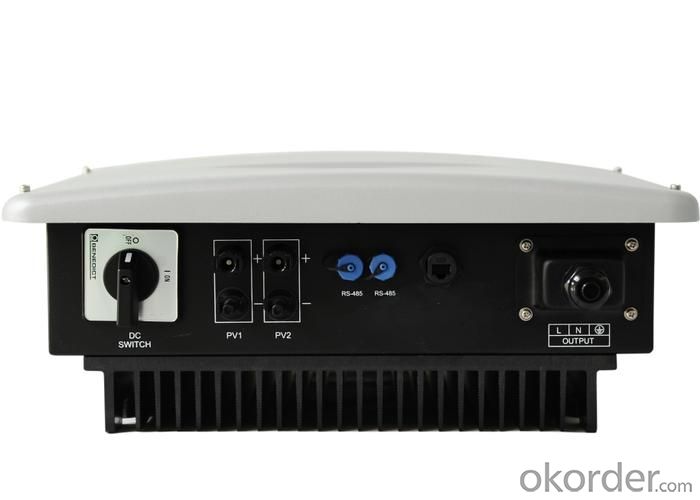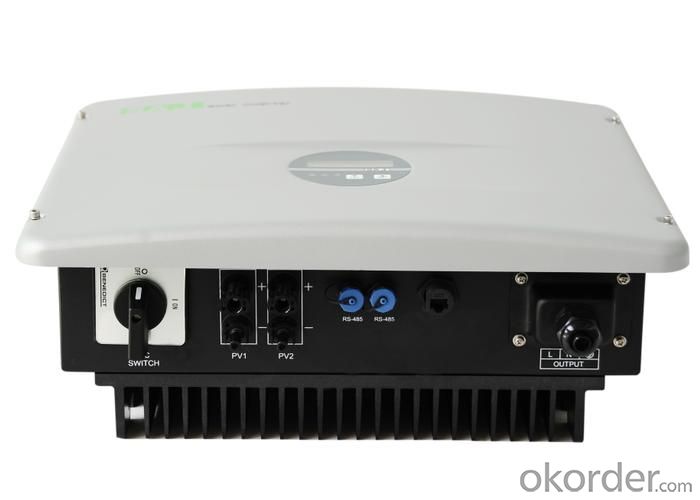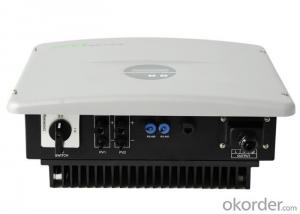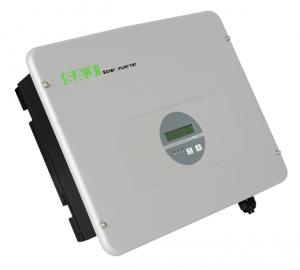On grid Solar Inverter Sununo-TL2K single phase
- Loading Port:
- China main port
- Payment Terms:
- TT OR LC
- Min Order Qty:
- 1 pc
- Supply Capability:
- 1000 pc/month
OKorder Service Pledge
OKorder Financial Service
You Might Also Like
Specification
1.Flexible
• Ethernet / Wi-Fi communication
• Wide range of DC input voltage
• IP65 for indoor and outdoor use
2.Reliable
• Comprehensive protection functions
• Compact design, fanless
• First-class components
3.Efficient
• Max. efficiency up to 97.7%
• Euro. efficiency up to 97.1%


• MPPT accuracy up to 99.9%
4. Certificates: TUV,SAA,G83,ISO9001,ISO14001,etc.
FAQ
1. How long will my inquiry get response?
Your inquiry related to our products or prices will be replied within 24 hours.
2. Can I get professional service and suggestion?
Well-trained and experienced staffs to answer all your questions in fluent English.
3. Do you accept OEM or customized design?
OEM & ODM, any your customized lightings we can help you to design and put into product.
4. What if I need specific design?
Distributorship are offered for your unique design and some our current models.
- Q:Can a solar inverter be used with a solar-powered water pump?
- Yes, a solar inverter can be used with a solar-powered water pump. A solar inverter converts the direct current (DC) generated by solar panels into alternating current (AC) that can be used to power various electrical devices, including water pumps. This allows the solar panels to directly power the water pump, making it an efficient and sustainable solution for water pumping applications.
- Q:What is the role of a power control feature in a solar inverter?
- The role of a power control feature in a solar inverter is to regulate and optimize the flow of electricity from the solar panels to the electrical grid or to the connected devices. It ensures that the power generated by the solar panels is converted and delivered efficiently, while also monitoring the voltage and frequency levels to maintain a stable and reliable power supply. Additionally, the power control feature enables the inverter to synchronize with the grid and comply with local regulations and requirements.
- Q:What are the key factors affecting the efficiency of a solar inverter?
- The key factors affecting the efficiency of a solar inverter include the quality and design of the inverter itself, the type and quality of the solar panels used, the temperature at which the inverter operates, and the level of shading or obstruction on the solar panels. Additionally, the efficiency can also be influenced by the electrical load connected to the inverter and the overall system design and installation.
- Q:How does a solar inverter handle voltage stability in the grid?
- A solar inverter handles voltage stability in the grid by continuously monitoring the voltage levels and adjusting its output accordingly. It ensures that the electricity generated from solar panels is synchronized with the grid voltage, maintaining a stable voltage level. Additionally, advanced solar inverters incorporate features like voltage regulation and reactive power control to further enhance voltage stability in the grid.
- Q:How does a solar inverter handle grid islanding conditions?
- A solar inverter handles grid islanding conditions by continuously monitoring the grid voltage and frequency. If it detects a deviation from the predefined range, it immediately disconnects from the grid to prevent energy feedback and potential damage. This ensures the safety of workers repairing the grid and protects the solar system from potential overvoltage or frequency-related issues.
- Q:What is the maximum number of solar panels that can be connected to a solar inverter?
- The maximum number of solar panels that can be connected to a solar inverter depends on various factors such as the power rating and specifications of the inverter, the total power capacity of the solar panels, and the design of the solar power system. It is best to consult the manufacturer's guidelines or a professional solar installer to determine the appropriate number of solar panels that can be connected to a specific solar inverter.
- Q:How does a solar inverter handle voltage and frequency variations caused by sudden load changes?
- A solar inverter is designed to handle voltage and frequency variations caused by sudden load changes in an efficient and reliable manner. When sudden load changes occur, the solar inverter employs various control mechanisms to regulate and stabilize the voltage and frequency output. Firstly, the inverter continuously monitors the voltage and frequency of the incoming solar power. If there are any variations due to sudden load changes, the inverter adjusts its internal control systems accordingly. It uses advanced power electronics and control algorithms to maintain the voltage and frequency within the desired range. To handle voltage variations caused by sudden load changes, the solar inverter employs a technique called voltage regulation. It automatically adjusts the output voltage by either boosting or reducing it as needed. This ensures that the inverter provides a stable and consistent voltage supply to the load, preventing any damage or malfunction. Similarly, to handle frequency variations caused by sudden load changes, the solar inverter employs a technique called frequency regulation. It adjusts the output frequency to match the grid frequency or the specified frequency requirements. By maintaining the desired frequency, the inverter ensures compatibility and synchronization with the grid or other connected devices. In addition to voltage and frequency regulation, solar inverters also have protective features to handle sudden load changes. They have built-in overload protection mechanisms that can detect excessive loads and prevent any damage to the inverter or the connected devices. These protective features can include overcurrent protection, short-circuit protection, and temperature monitoring. Overall, a solar inverter is designed to handle voltage and frequency variations caused by sudden load changes through its voltage and frequency regulation capabilities, as well as its protective features. These technologies ensure stable and reliable operation, allowing the inverter to efficiently adapt to changing load conditions while maintaining the integrity of the power supply.
- Q:Can a solar inverter be used with a wind turbine?
- Yes, a solar inverter can be used with a wind turbine. Both solar panels and wind turbines generate DC (direct current) electricity, which needs to be converted to AC (alternating current) to be used in most household appliances and the electrical grid. A solar inverter is designed to convert DC electricity from solar panels into AC electricity, and it can also be used to convert the DC electricity generated by a wind turbine into AC electricity. However, it is important to note that wind turbines usually generate higher voltage and fluctuating currents compared to solar panels, so the inverter used with a wind turbine may need to be specifically designed to handle these variations. Additionally, wind turbines often have their own specialized inverters that are optimized for their unique electrical characteristics.
- Q:How does a solar inverter handle harmonics in the grid?
- A solar inverter handles harmonics in the grid by implementing various techniques such as filtering, synchronization, and control algorithms. These techniques help in mitigating harmonics and ensuring that the power generated from the solar panels is synchronized and compatible with the grid's electrical frequency and voltage. The inverter's control system monitors the grid's harmonics and adjusts its output accordingly to minimize any adverse effects and maintain grid stability.
- Q:Can a solar inverter be used with a solar-powered refrigerator?
- Yes, a solar inverter can be used with a solar-powered refrigerator. A solar inverter is responsible for converting the direct current (DC) produced by solar panels into alternating current (AC) that can be used to power appliances, including refrigerators. Therefore, a solar inverter is an essential component in connecting a solar-powered refrigerator to a solar panel system.
1. Manufacturer Overview |
|
|---|---|
| Location | |
| Year Established | |
| Annual Output Value | |
| Main Markets | |
| Company Certifications | |
2. Manufacturer Certificates |
|
|---|---|
| a) Certification Name | |
| Range | |
| Reference | |
| Validity Period | |
3. Manufacturer Capability |
|
|---|---|
| a)Trade Capacity | |
| Nearest Port | |
| Export Percentage | |
| No.of Employees in Trade Department | |
| Language Spoken: | |
| b)Factory Information | |
| Factory Size: | |
| No. of Production Lines | |
| Contract Manufacturing | |
| Product Price Range | |
Send your message to us
On grid Solar Inverter Sununo-TL2K single phase
- Loading Port:
- China main port
- Payment Terms:
- TT OR LC
- Min Order Qty:
- 1 pc
- Supply Capability:
- 1000 pc/month
OKorder Service Pledge
OKorder Financial Service
Similar products
New products
Hot products
Hot Searches
Related keywords






























